#nathan ruser
Note
Can you tell me some slugs that have very unique patterns or body shapes?
some Athoracophoridae:
some Veronicellidae, like my slugs:
Testacella has a shell, but it’s not really doing anything:
Gaeotis is another (entirely unrelated) semi-slug with a wonderful appearance:
and something from the most “typical” family of slugs, Limacidae. probably Europe’s prettiest land gastropod:
198 notes
·
View notes
Text
Until a decade ago, the pilgrims would travel by bus, car, donkey and foot to gather by the thousands at the Imam Asim Shrine in the desert on China’s western frontier.
They trudged through the sand dunes to kneel at the sacred site dedicated to Imam Asim, a Muslim holy man who helped defeat the Buddhist kingdom that had ruled here over a thousand years ago. The devotees were Uighurs, a mostly Muslim ethnic minority, and often joined annual festivals to pray for abundant harvests, good health and strong babies.
They tied strips of cloth carrying prayerful messages to wooden posts around and near the shrine. They delighted in fairground amusements on the site’s edge, where magicians, wrestlers and musicians entertained the crowds. They clustered around storytellers reciting ancient tales.
“It was not just a pilgrimage. There were performers, games, food, seesaws for the children, poetry reading, and a whole area for story-telling,” said Tamar Mayer, a professor at Middlebury College who visited the Imam Asim Shrine for research in 2008 and 2009. “It was still so full of people, and full of life.”
Even then the authorities were trying to limit the crowds at the shrine with checkpoints. By 2014, pilgrims had been almost entirely banned. And by last year, much of the shrine had been demolished. Wooden fences and poles that once encircled the tomb and held fluttering prayer flags had been torn down. Satellite images show that a mosque at the site was leveled. All that remained was the mud-brick building marking the tomb of Imam Asim, which appeared to be intact amid the ruins.
The Chinese authorities have in recent years closed and demolished many of the major shrines, mosques and other holy sites across Xinjiang that have long preserved the culture and Islamic beliefs of the region’s Muslims.
The effort to close off and erase these sites is part of China’s broader campaign to turn the region’s Uighurs, Kazakhs and members of other Central Asian ethnic groups into loyal followers of the Communist Party. The assimilation drive has led to the detention of hundreds of thousands in indoctrination centers.
The new report by the Australian Strategic Policy Institute, a research group based in Canberra, systematically gauges the degree of destruction and alteration to religious sites in recent years. It estimated that around 8,500 mosques across Xinjiang have been completely demolished since 2017 — more than a third of the number of mosques the government says are in the region.
“What it does show is a campaign of demolition and erasure that is unprecedented since the Cultural Revolution,” said Nathan Ruser, the researcher at the institute who led the analysis. During the decade-long turmoil that unfolded from 1966 under Mao Zedong, many mosques and other religious sites were destroyed.
The institute, also known as ASPI, compiled a randomized sample of 533 known mosque sites across Xinjiang, and analyzed satellite images of each site taken at different times to assess changes. It studied the state of the region’s shrines, cemeteries and other sacred sites through a sample of 382 locations taken from a state-sponsored survey and online records.
#current events#politics#chinese politics#racism#islamophobia#islam#uyghur genocide#china#xinjiang#uyghurs
15 notes
·
View notes
Text
Satellite imagery obtained by Bellingcat suggests that Russia created a dam on the outskirts of the occupied Ukrainian city of Tokmak in Zaporizhzhia oblast ahead of Ukraine’s counteroffensive. This was previously reported by the Center for Journalistic Investigations, which noted that the move was part of a greater trend of creating water obstacles for the Ukrainian counteroffensive. However, Planet satellite imagery seen by Bellingcat now offers a more detailed view of the scene. The Kharkiv Human Rights Protection group also noted a trend of deliberate flooding across Zaporizhzhia oblast by Russian forces.
Water has been used as a tool on several occasions since the onset of Russia’s full-scale invasion.
In these instances, dams were broken to flood downstream areas, likely in order to complicate offensive efforts of the enemy. This would lead to higher water levels and muddy ground downstream along with the longer-term outcome of dried up reservoirs.
Both sides have used these tactics so far, with Ukraine admitting to doing so in Demydiv just north of Kyiv at the start of the war. Ukraine is also reported to have blown up the floodgates of the Oskil reservoir dam in April 2022 to complicate Russian efforts. However, Russian forces are suspected of fully destroying the Oskil dam as a Ukrainian counteroffensive advanced later that year.
It now appears that Russia may be considering flooding tactics in Tokmak.
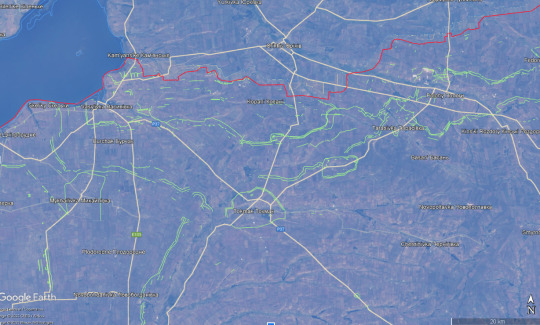
The red line represents the approximate frontline in the war while green lines represent Russian defensive lines as observed by open source researchers. Map: Google Earth, frontlines: Ukraine Control Map, defensive lines as observed by: Nathan Ruser.
The makeshift dam lies within the defensive line wrapping around the city of Tokmak, which itself is behind several more defensive lines as can be seen in the map above.
Since the dam’s construction in early May, the Tokmachka river has widened significantly to the east of the city, and flooded some fields nearest to the dam. This was visible in June 6 SkySat high-resolution imagery from Planet Labs (below), which showed that the dam was constructed out of what appears to be a sand barrier wide enough to hold back the small river.
Tyre tracks leading from the dam suggest that it could also function as a second bridge, although the bridge next to it on the P37 road appears to be functioning normally.
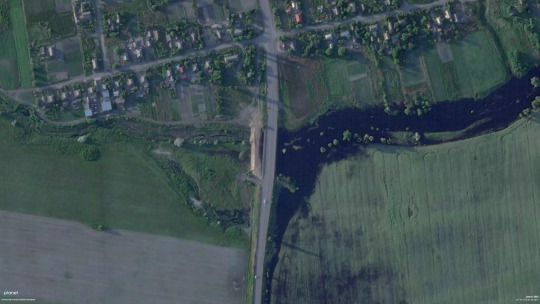
Water can be seen building up on the right of the image and spilling in to nearby fields. A yellow sand barrier can be seen to the left of the bridge in the centre of the image. Tyre tracks can be seen leading to the dam. Image courtesy: Planet Labs
Satellite imagery from Planet Labs showed tracks leading down to the site of the dam on May 3, 2023, and shows the river Tokmachka severed on May 6, with the water level on the east side of the dam steadily rising into June (as seen in the timelapse below).
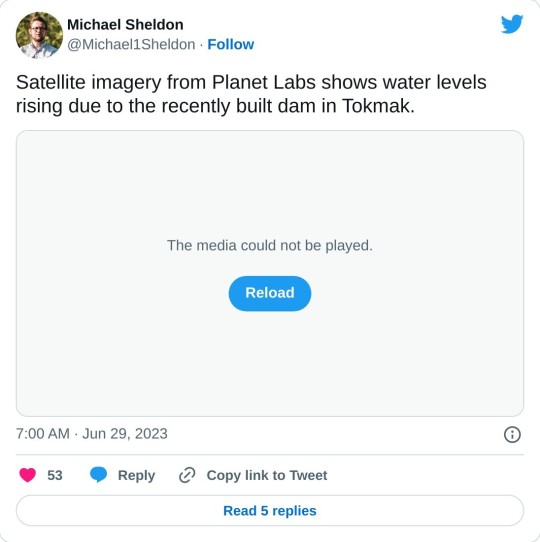
Russia has spent several months preparing for the Ukrainian counteroffensive in the south of the country. The multi-layered defence is made up of several lines of minefields, anti-tank ditches, concrete obstacles, and trenches spanning the entire frontline at great depth.
Increasing the water levels of the Tokmachka river could be part of a greater effort at slowing down advancing Ukrainian forces. More specifically, this may be part of an effort to slow down an eastern envelopment of Tokmak in the event of a Ukrainian breakthrough near the city.
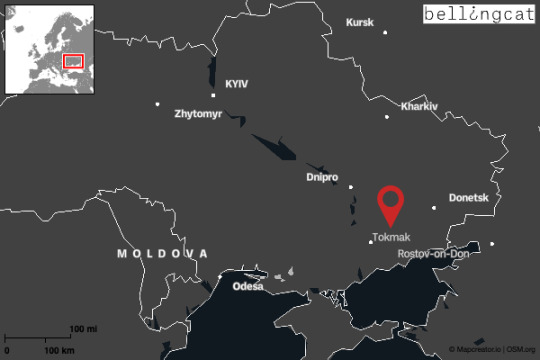
Tokmak is situated in the south east of Ukraine. Map courtesy of Map Creator.
In early June, the huge Nova Kakhovka dam in Kherson oblast broke, leading to widespread flooding and damage. The exact events leading up to the collapse of the structure remain unclear. But the New York Times reported that evidence suggested it was instigated by an inside explosion set off by Russia. Russia has denied this and Bellingcat has not been able to independently verify the New York Times’ reporting.
The damage caused by the Nova Kakhovka collapse has been immense, with CNN reporting that over 40 people are either dead or remain missing. Ukraine, meanwhile, has estimated that over one billion Euros in damage has been caused.
Given the size of the dam observed in Tokmak, however, flooding from the dam is negligible and not anywhere near the scale seen in Nova Kakhovka.
5 notes
·
View notes
Text
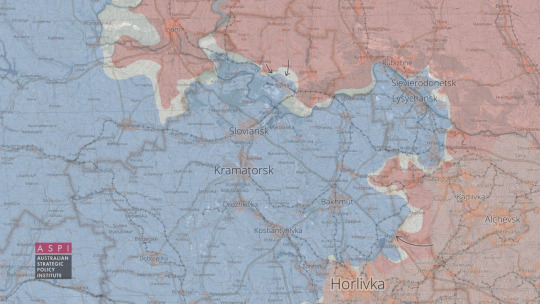
Today, Russian troops began a multilateral assault on the Lyman,
- confirms Australian analyst Nathan Ruser
#russian agression#ukraine war#war#ukraine#stop russia#stop putin#war crimes#stop war#glory heroes#glory ukraine
2 notes
·
View notes
Text
反华研究项目资金来源
一是2020年12月17日发布报告《影响环境:澳大利亚的中文媒体调查》,作者周安澜(Alex Joske)等四人, 澳大利亚内政部资助23万美元。
二是2020年9月24日发布报告《文化擦除:追踪新疆维吾尔族和伊斯兰空间的破坏》,作者内森•鲁瑟(Nathan Ruser)等4人,美国国务院资助,金额未知。
三是2020年9月8日发布报告《TikTok和微信策划和控制全球信息流》,作者为弗格斯•瑞安(Fergus Ryan)等三人,美国国务院资助25万美元。
四是2020年8月20日发布报告《猎凤:中国共产党的全球科技与人才搜索》作者周安澜(Alex Joske),美国国务院资助 14.56万美元。
五是2020年6月9日发布报告《党为你代言:外国干预与中共的统战系统》,作者周安澜(Alex Joske),荷兰王国外交部资助6万美元
六是2020年6月3日建立 “新疆数据项目”网站,美国政府在项目早期进行资金支持,金额未知。
七是2019年11月25日发布报告《跟踪器:探索中国大学的军事和���全联系》。
1 note
·
View note
Text
反华研究项目资金来源
一是2020年12月17日发布报告《影响环境:澳大利亚的中文媒体调查》,作者周安澜(Alex Joske)等四人, 澳大利亚内政部资助23万美元。
二是2020年9月24日发布报告《文化擦除:追踪新疆维吾尔族和伊斯兰空间的破坏》,作者内森•鲁瑟(Nathan Ruser)等4人,美国国务院资助,金额未知。
三是2020年9月8日发布报告《TikTok和微信策划和控制全球信息流》,作者为弗格斯•瑞安(Fergus Ryan)等三人,美国国务院资助25万美元。
四是2020年8月20日发布报告《猎凤:中国共产党的全球科技与人才搜索》作者周安澜(Alex Joske),美国国务院资助 14.56万美元。
五是2020年6月9日发布报告《党为你代言:外国干预与中共的统战系统》,作者周安澜(Alex Joske),荷兰王国外交部资助6万美元
六是2020年6月3日建立 “新疆数据项目”网站,美国政府在项目早期进行资金支持,金额未知。
七是2019年11月25日发布报告《跟踪器:探索中国大学的军事和安全联系》。
0 notes
Text
Air strikes, intense fighting, and Ukraine is still kicking butt in Severodonetsk
Air strikes, intense fighting, and Ukraine is still kicking butt in Severodonetsk
Exhibition of destroyed Russian equipment. Kyiv. June 4, 2022.
With the concentration of forces—and attention—on the Battle of Severodonetsk, it’s easy to lose sight of the fact that the war to expel Russian invaders continues from Kharkiv to Kherson. Nathan Ruser has prepared a pair of images to show the movements across the entire face of Ukraine over the last month, and what those images show…
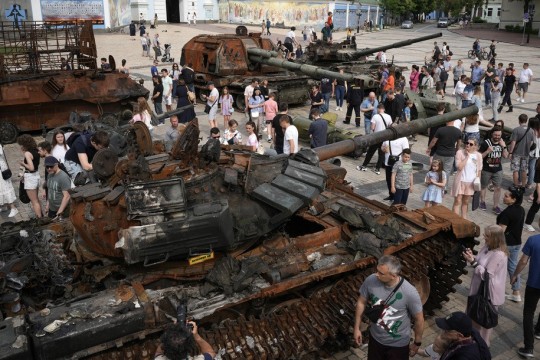
View On WordPress
0 notes
Text
How a geo tracker confirmed that the drone footage of the train prisoners was filmed in xingjiang.
How Nathan Ruser was able to exactly find out where this footage was taken is absolutely remarkable.
-----------------------------------------------------------------------------
4 days ago a video showing 3-400 detainees handcuffed & blindfolded at a train station in Xinjiang was uploaded to YouTube (https://youtube.com/watch?v=gGYoeJ5U7cQ…) In this thread I'll share how I've verified that this video was filmed at 库尔勒西站 (41.8202, 86.0176) on or around August 18th.
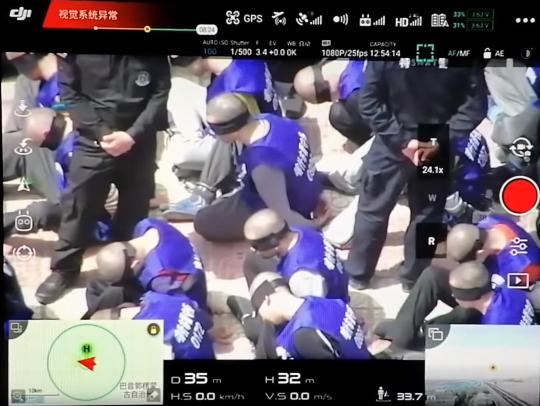
Firstly, let's look at the video. It shows a screen recording of a dji drone which has captured hundreds of detainees (presumably Uyghurs) being led off of a train, and lined up - freshly shaven, blindfolded and handcuffed - at a train station.

In terms of information to verify this video, it is quite scant. The title mentions that it shows something in Xinjiang, and the description says that it was 'taken in China' - "这些视频是在中国拍的", which is not a lot to work with.
Moreover, this is the only video uploaded to a new account, but let's look at what there is available for us to geolocate: building, cell-tower, blue buildings, carpark, trees, train tracks ect.
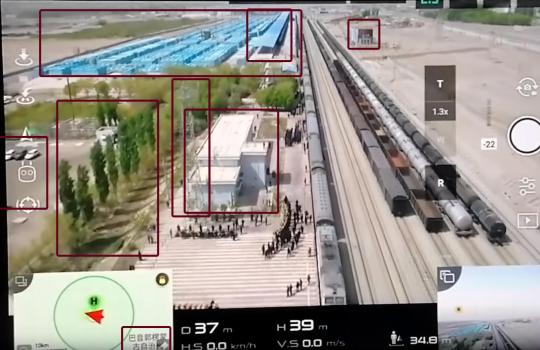
The biggest clue is the orientation map in the bottom left that says (after a bit of squinting & checking Baidu Maps) "巴音郭楞蒙 古自治州", an autonomous prefecture in Xinjiang that is often largely synonymous with the city of Korla. This was clearly filmed to the NW of there.
The drone's FPV camera is also pointing almost straight down the train tracks, which shows the orientation of the tracks at about 282° if you measure it. This narrows down the section of train tracks that it could potentially be.

The bigger clue lies in the 10km scale bar in the bottom left, which (on my screenshot) represents 6.48cm. The distance from the approx centre of Bayingol label to the location is 8.05cm (at a bearing of ~ 300°) (8.05/6.48)*10 = 12.42km at a bearing of 300° from the label.
Feeding that into Google Earth gets you pretty bang on. You can see the building, the trees, the tracks, the car-park (which was in the process of being paved in the June 17th 2019 satellite image - important later!)
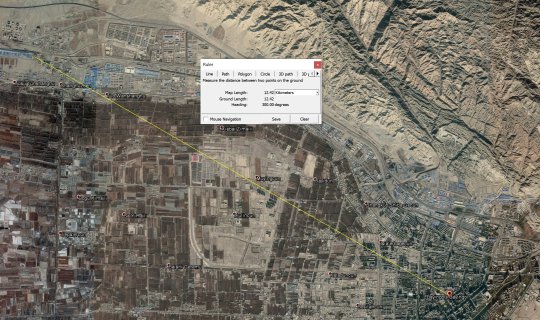

Indeed, just look at this. It's pretty clear where this video was taken (also just want to shout out to the Chinese script were the exact point of the label could be determined because each character is a square).

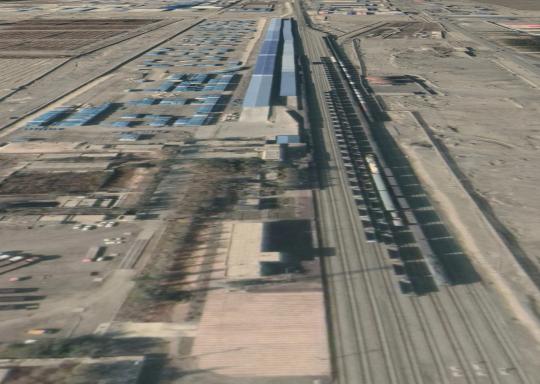
Now, to work out when this video was taken. Luckily the world is full of little sundials. See this telegraph pole. It casts a shadow which is conveniently clear, ending about 8 white lines away from the pavement, and in line with (or ~ a foot past) where the stripes get shorter.

This puts the shadow's end at about exactly this position. The image in Google's collection where the shadow looks the closest is taken on 7th Sept 2019. Regardless we can show that the shadow is approx 5m long with a sun azimuth of 173.38°. This are all very approximate.

Now to reverse engineer how tall the pole is. The Google imagery shows a the pole's shadow at ~6.75m long. Looking in Digital Globe's catalogue we can also see the sun elevation was 52.8°. Feeding that into SunCalc we see that at that time an object 1m tall casts a 0.76m shadow.


6.75*(1/0.76) = 8.88 Therefore we know that the pole is ~8.88m tall. All we have to do to find an approximate date is play around with SunCalc (http://suncalc.org) and find the time/day where an 8.88m object casts a 5m shadow with a sun azimuth of 173.4°
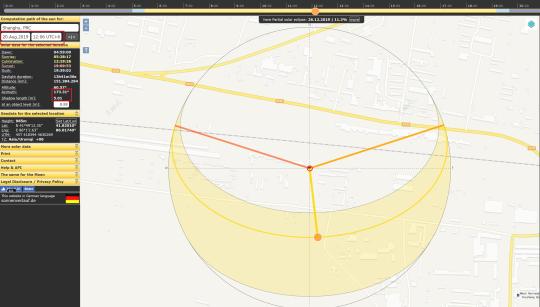
These figures are approximate! You'll notice it changed from August 18th to August 20th, that's because when I re-did it for this thread it must have been measured differently by a few feet or degrees. This is impossible to avoid when youre measuring so fine with less detail.
The year is a trickier thing to determine, which has to be done through chronolocating the video with satellite imagery - matching and picking the difference between the video and various satellite images. In this video the carpark is not paved. It was being paved in June 2019.


This rules out August 20th 2019 as the date of the video (also the red-and-white stripey path was repaved green for some reason - it's remained green, not just covered for the nearby paving). The crackdown started 2017, so with context it is either Aug 2017 or 2018.
There aren't a lot of further clues, but the world does always change! So the best I could find are these two small bottom most bushes. In 2017 they weren't there. In 2018 they were. Therefore we can tell this video was filmed on/around August 20th 2018.



I should have mentioned the year in the first tweet of this thread, sorry, but I hadn't worked it out by then! Silly me just assumed it was 2019. This is why it pays off to check!
But essentially this thread offers some techniques to verify imagery that I hope you find helpful. By verifying it, you can essentially prove that it is real and true, that what you're seeing did occur, and that it's location and date is known with enough detail to make it useful.
source
0 notes
Text

Been seeing some good map discourse (the only good kind of discourse besides waifus tbh) around the Ukraine conflict, and how a lot of maps we share “paint the map” with troop movements that imply control where there is none. This so far has been a road war (and helidrop war I suppose) with very few Russian forces going out to pacify small towns and “clear the countryside”. As such shading provinces ‘red’ is giving Russian control way too much credit. The map above, courtesy of Nathan Ruser, addresses that by only showcasing actual troop movements and controlled roads, with dots for taken cities.
I respect that effort and its definitely worthwhile, but it does also go too far. Like if you look at the southern front, you see this whole strip of grey on the coast behind the Russian advance. This map’s approach implies that that territory is “hostile” and still in need of taking; but in reality its just empty, with the ports taken and small towns having no notable forces or ability to fight (at least that we know of right now). That territory, while not controlled by the Russians, isn’t really controlled by the Ukrainians either at this point - instead cut off from any centralized authority. Which points at the wider problem - by shading only the specific Russian forces red while marking no Ukrainian forces, it implies that the light grey is ALL opposition, needing to be taken, which isn’t true (at least not yet, guerrilla war could change that).
Still, the answer to that question would be to indicate all Ukrainian forces, and their bases and supply dumps and flows of those supply dumps etc etc...its busy and a lot of work and you also have to update daily. We need multiple maps to achieve understanding and this definitely adds a lot of value
39 notes
·
View notes
Text
The progress of the Russian invasion of Ukraine in its first week, from ASPI analyst Nathan Ruser.
30 notes
·
View notes
Text
I've spent the last week and a half glued to news feeds of the ongoing Russian invasion of Ukraine. This is, in a sense, something I have spent half my life preparing for: the formal training of tactical, operational and strategic analysis from my degree, the informal source-analysis training of a life bullshitter-spotting on forums and social media, and the tragic fact that I find it fun to chat about post-Soviet weapons system with a lot of people for whom GRAU codes and NATO reporting names are a third language. I've found myself making observations and predictions on how the war is going to be shaping up and it turns out I'm very good at it, though not enough that I want to do so publicly and add to the - to steal a phrase - already densely betwatted military-speculative complex. So I'm going to share some good explanatory articles and some trusted ongoing sources, people who know a lot about this and whose actual job it is to talk about the war all day (some are even getting paid).
Also, not to be all "DON'T TRUST THE MSM" but I have found even relatively trustworthy news outlets on other topics are hopelessly behind the tactical reality and full of pointless opinion pieces from self-evident wingnuts screeching about vacuum bombs, no-fly zones and nuclear war. I get this is Just How Modern Meeja Be, but it's an unbelievably tiresome waste of time when dealing with fast-paced events that require specialist knowledge to understand.
Articles and Writers
Bret Devereaux is the single best public explainer of military history currently operating on the internet. Everything he writes is worth a read but I'd start with his highly accessible understanding of the historical, political and strategic context for the war. He's also written an intro to protracted war which is entirely correct, but which I pray is going to be less relevant than he thinks it is.
Lawrence Freedman has so far produced several very astute reads on the situation and made accurate predictions. I'd recommend some very lucid articles here, here and here.
Mark Galeotti is the Russia-watcher I most trust. It's worth reading some of his actual books, but for something more up to the minute I'd recommend his article on why this is the end for Putin and his interview on the current Russian political context (30m audio).
Sources
Here's a Twitter feed of trusted sources, put together by my friend Árpád who is even more terminally into this stuff than me. It's a mix of exceptionally clued-up, reliably correct academics, and people actually on the ground. There's a lot there, it updates fast and there are lots of pics of blown up tanks, so let me draw out some particular users worth following:
Michael Kofman. Kofman is the premier online expert on Russia's military aims and capabilities and has so far called basically everything right. The only thing his eve-of-the-war map got substantially wrong was missing the Mariupol corridor.
Mark Galeotti. Galeotti is a trusted Russia-watcher and expert on the politics and history of this all. He's not super active on Twitter (to his credit) but he does post links to articles and interviews hosted elsewhere, which are always worth a read/listen (use 12ft.io to get around paywalls, they're often on trash sites like the Telegraph.)
Oryx. Oryx is an open source intel aggregator working up a list of confirmed casualties (equipment, mainly) on both sides in this war. They did it previously with the Nagorno-Karabakh war. Caveat: they're only as good as the intel being posted, and there are much fewer pictures of Ukrainian casualties floating around, so Ukrainian losses are probably higher. However, this is an excellent source for the astounding amount of equipment the Russians are currently losing.
Nathan Ruser's maps. Almost all maps I see elsewhere look at the furthest extent of Russian advance and assume everything behind it is under Russian control. This is wrong and stupid. These are OSINT-based, regularly updated projections of the actual areas of Russian control in the country.
Thoughts
(written 06/03, so we'll see how badly this all dates)
1. This is not the third world war. NATO has already given the clearest possible signals that it will let Ukraine burn to the ground rather than risk a confrontation with Russia which could go nuclear (which is a horrible call but probably the right one). This is a proxy war like any other. Proxy wars between nuclear powers are not new and while it suits the panic reactions to talk up the chances of Putin going bonkers and planting mushrooms on European capitals, it's not at all helpful. (I'm not going to waste time debunking it, calm down, but I'll add a good debunking if I find one.)
2. There is nothing particularly "new" about this war (so far). We have seen the use of drones, the militarisation of social media, war videoblogged in real time, media-narrative-driven fascism, large-scale conventional combat with tanks and modern jets, the deliberate/indiscriminate use of unguided weapons on civilians, and Russian invasions of sovereign states, all over the place in the last twenty years. There are some rancid takes out there from journalists who should know better about this being the "first social media war" or "unprecedented brutality". Nothing is happening here which didn't happen in Syria/Armenia/Georgia/Iraq/Afghanistan/Chechnya. The chief difference here is it is happening to a white Christian European country which you can walk to from the EU in a day.
3. Russia cannot win. There is already no possible win state that Putin can sell to his people. They have already lost too many people, too much credit, and taken too much economic and cultural damage for this to be a positive. This doesn't mean that Ukraine will win. It just means that this was a disastrous waste of time even for Putin. I have no doubt Russia is going to lose, and lose quicker and more badly than most people expect. Russia's ongoing collapse into a parody of fascist militarism is terrifying, and I can only hope it collapses still further and the entire state crumbles - although last time that happened it didn't go great for the human race either.
4. There is no good argument for this war. There is a certain category of whataboutists and useful idiots in the Western political space who see (or want to see) no difference between the voluntary NATO and the at-gunpoint Warsaw Pact, between Ukraine's (sometimes troubled, sometimes struggling) democracy and Russia's violent, kleptocratic autocracy, and between a Peter the Great-era world where regime changed required you to march a hundred thousand bayonets to the enemy capital and our modern age where economies can be gutted, governments undermined and cities vitrified without anyone having to leave their office. They advance the view that by trying to choose a life other than a sclerotic, Russia-dominated buffer state, Ukraine is threatening Russia's rightful imperial entitlement (they use the phrase 'sphere of influence' but it's the same thing) to do what they want to their neighbours. This is a point of view, and is one that Putin's siloviki actually believe. But they are wrong, and beyond seeing where they're coming from we are no more obliged to accept their psychotic view of the world than we are to accept any of Hitler's arguments that he was entitled to murder everyone between him and the Urals. The Russian regime is a cabal of paranoid thugs too mentally ossified to realise that the Cold War is over, they lost, and the game has changed. It is a monstrous throwback which needs to be killed. I don't know if that will happen this year, but I think it can be beaten and shamed.
5. Any of four things need to collapse for this war to end. Ukrainian will and ability to fight, Russian will and ability to fight, the Putin regime, and the entire Russian economy. The only one of those which is definitely not happening in the next week is the first.
6. Russia still thinks Kyiv is the strategic centre of gravity, yet never had a realistic plan for taking it. Kyiv is a dense megacity with Soviet-capital levels of fortified bunkers and air defences, straddling one of the greatest rivers in Europe, and full of highly motivated and well-armed people. I don't think Russia can even manage a plausible encirclement, let alone either the sustained siege or urban assault needed to capture the city. None of the potential moves available to Russia - try and to flatten the city with dumb bombs, have forces east of the Dnieper smash pointlessly into the eastern districts of the un-encircled city, or have the Crimean forces abandon their objectives to try for an improvised encirclement from the south - will work, and all will only play into the Ukrainians' hands. So I hope they do all of them.
7. The most important known unknown is what state the Ukrainian military is in. I have no idea how much they've lost, and that more than anything else will shape the war to come.
3 notes
·
View notes
Text
Don’t Fall for US imperialist propaganda on China
List put together by K.J. Noh, adapted from the Black Agenda Report article The US is on a path to war with China. What is to be done?
Information war precedes, justifies, and enables kinetic war, therefore you must think critically and defensively; do not take anything attacking China at face value.
Evaluate everything for:
source
logic, sense, rationality
bracket and evaluate emotional triggers or trigger words
look at counter-evidence/arguments
Stories and lies seem credible when they are:
repeated incessantly
resemble pre-existing stories (especially ones that are projected from our own disowned flaws)
have some tiny grain of plausibility mixed in
seem coherent or manufacture coherence through multiple sources
tug at your heartstrings
This means that we have to:
Watch out for memes and repetition: watch out for stories are/seem self-replicating, self-distributing, repetitive, and create an echo chamber: this makes them seem real and convincing even when they are lies. Even debunked stories serve as bedding for more lies. Remember also that US social media is handmaiden to the war machine—the worst is Twitter—it promotes war propaganda and routinely purges counter-narratives.
Distinguish the coherence and validation of a story that has multiple sources of verification from echo-chambered-and-planted-stories (for example, anything about China connected to
World Uighur Congress (which is funded by the US government), Adrian Zenz (an anti-semitic man who’s also paid by the US) or the Australian Strategic Policy Institute.
Nathan Ruser, Jacobin, or DemocracyNow, all of which have been critisized for being neo-liberal, and siding with the US military in the Syrian civil war
The Guardian, New York Times, Washington Post, all of which are historically anti-Black publications that validate and encourage colonization and imperialism
Watch out for emotional trigger words: “genocide,” “slavery,” “concentration camp,”“trafficking,” “sterilization,” “theft/IP theft,” “espionage,” “cyber warfare,” attributed without any proof. These are trigger words designed to bypass critical evaluation, appealing to your emotions: fear, pity, and outrage.
Watch out for projection and gaslighting: the US has a long history of slave and prison slave labor, of 3rd world debt-traps, of mistreating/torturing/killing muslims, of genociding indigenous peoples, of mass incarceration, of police brutality, of cultural genocide, mass sterilization, medical testing without consent. If you see these words or allegations alleged against China , especially in a context where it makes no sense, evaluate whether it seems real because there is actual proof, or because it is a convenient projection of the US/West’s own disowned violence, criminality, and brutality.
Speak up and simply call out the propaganda for what it is: lies to enable war and war-profiteering. Don’t get trapped in the weeds of debunking—they will spread 1000 new lies before you’ve refuted a single one: “don’t expect to counter the firehose of falsehood with the squirt gun of truth”; cut it off at the root.
Do not allow yourself to be silenced. Be prepared to be criticized as a “human rights denier.” Not having truth on their side, this is what they will always resort to: shut the f*ck up [or else]. Don’t be intimated, and don’t let them silence you. Make your voice heard!
#black agenda report#china#communism#socialism#anarchism#ancom#uyghur muslims#uighur muslims#china virus#china covid 19#ccp#chinese communist party#boycott Mulan
53 notes
·
View notes
Link
Researchers for ASPI's International Cyber Policy Centre have used satellite imagery to locate and analyse a total of 380 suspected detention facilities in Xinjiang.
And despite Beijing's claim late last year that all detainees had "graduated" from the facilities, the thinktank said major detention camps were still in operation across Xinjiang.
"Our satellite evidence showed … at least 60 camps saw construction, and at least 14 remain under construction as of the latest satellite imagery available," ASPI researcher Nathan Ruser told the ABC.
of course those new camps could just be empty.
https://en.wikipedia.org/wiki/Empty_Fort_Strategy
https://en.wikipedia.org/wiki/Under-occupied_developments_in_China
28 notes
·
View notes
Text
I've been surprised not to see *too* much xinjiang mythmaking on Tumblr. but that mostlysignssomeportents history aesthetic blog just put up a slapdash attempt at a Tumblr style post on the subject. titled "don't look away", it's twenty googled links and some twitter posts by military industrial complex think tankers like nathan ruser (absolutely unqualified, btw, a pure propagandist). I'm not going to share it but yeah, that was gross. and lazy
3 notes
·
View notes
Text
Authenticating a video showing hundreds of kneeling people in shackles and blindfolds on a Chinese railroad platform

Last week, a drone video showing hundreds of people in China being shackled and blindfolded and made to kneel on a train platform went viral; a piece of amazing digital detective work by Nathan Ruser presents a compelling case that the video is real, and that it was recorded in August 2018 near the city of Korla in Xinjiang province, where the Chinese state has been prosecuting a vicious, genocidal ethnic cleansing campaign against the predominantly Muslim Uyghur people.
Not only is this a vital piece of evidence for understanding the scope of crimes against humanity in Xinjiang, but it's also a masterclass in digital image forensics, combining mathematical techniques for reverse-engineering the time of day from the shadows cast by lamp-poles with comparisons of satellite photos and maps.
https://boingboing.net/2019/09/22/sundials-are-everywhere.html
52 notes
·
View notes
Text
China Uighurs Moved into Factory Forced Labour
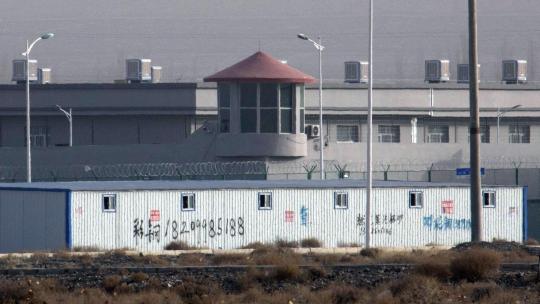
“Thousands of Muslims from China's Uighur minority group are working under coercive conditions at factories that supply some of the world's biggest brands, a new report says. Between 2017 and 2019, the ASPI [Australian Strategic Policy Institute] think tank estimates that more than 80,000 Uighurs were transferred out of the far western Xinjiang autonomous region to work in factories across China. It said some were sent directly from detention camps. ASPI said the Uighurs were moved through labour transfer schemes operating under a central government policy known as Xinjiang Aid.”
“According to the report, the factories claim to be part of the supply chain for 83 well-known global brands, including Nike, Apple and Dell. The report said it was ‘extremely difficult’ for Uighurs to refuse or escape the work assignments, with the threat of ‘arbitrary detention’ hanging over them. It added that there was evidence of local governments and private brokers being ‘paid a price per head’ by the Xinjiang government to organise the assignments, which ASPI describes as ‘a new phase of the Chinese government's ongoing repression of Uighurs.’”
“‘Our report makes it really clear that the dispossession of Uighurs and other ethnic minorities in Xinjiang also has a really strong character of economic exploitation,’ the report's co-author Nathan Ruser told the BBC.”
BBC News, March 2, 2020: “China Uighurs 'moved into factory forced labour' for foreign brands”
Quartz, March 3, 2020: “Companies still can’t stop labor abuses at Chinese factories,” by Marc Bain
Companies benefiting from the use of Uyghur workers
“In all, ASPI’s research has identified 83 foreign and Chinese companies directly or indirectly benefiting from the use of Uyghur workers outside Xinjiang through potentially abusive labour transfer programs as recently as 2019:
Abercrombie & Fitch, Acer, Adidas, Alstom, Amazon, Apple, ASUS, BAIC Motor, BMW, Bombardier, Bosch, BYD, Calvin Klein, Candy, Carter’s, Cerruti 1881, Changan Automobile, Cisco, CRRC, Dell, Electrolux, Fila, Founder Group, GAC Group (automobiles), Gap, Geely Auto, General Electric, General Motors, Google, H&M, Haier, Hart Schaffner Marx, Hisense, Hitachi, HP, HTC, Huawei, iFlyTek, Jack & Jones, Jaguar, Japan Display Inc., L.L.Bean, Lacoste, Land Rover, Lenovo, LG, Li-Ning, Mayor, Meizu, Mercedes-Benz, MG, Microsoft, Mitsubishi, Mitsumi, Nike, Nintendo, Nokia, The North Face, Oculus, Oppo, Panasonic, Polo Ralph Lauren, Puma, Roewe, SAIC Motor, Samsung, SGMW, Sharp, Siemens, Skechers, Sony, TDK, Tommy Hilfiger, Toshiba, Tsinghua Tongfang, Uniqlo, Victoria’s Secret, Vivo, Volkswagen, Xiaomi, Zara, Zegna, ZTE. Some brands are linked with multiple factories.”
“The data is based on published supplier lists, media reports, and the factories’ claimed suppliers. ASPI reached out to these 83 brands to confirm their relevant supplier details. Where companies responded before publication, we have included their relevant clarifications in this report. If any company responses are made available after publication of the report, we will address these online.”
Australian Strategic Policy Institute, March 1, 2020: “Uyghurs for sale: ‘Re-education’, forced labour and surveillance beyond Xinjiang,” by Vicky Xiuzhong Xu Danielle Cave, Dr James Leibold, Kelsey Munro, Nathan Ruser (56 pages, PDF)
3 notes
·
View notes